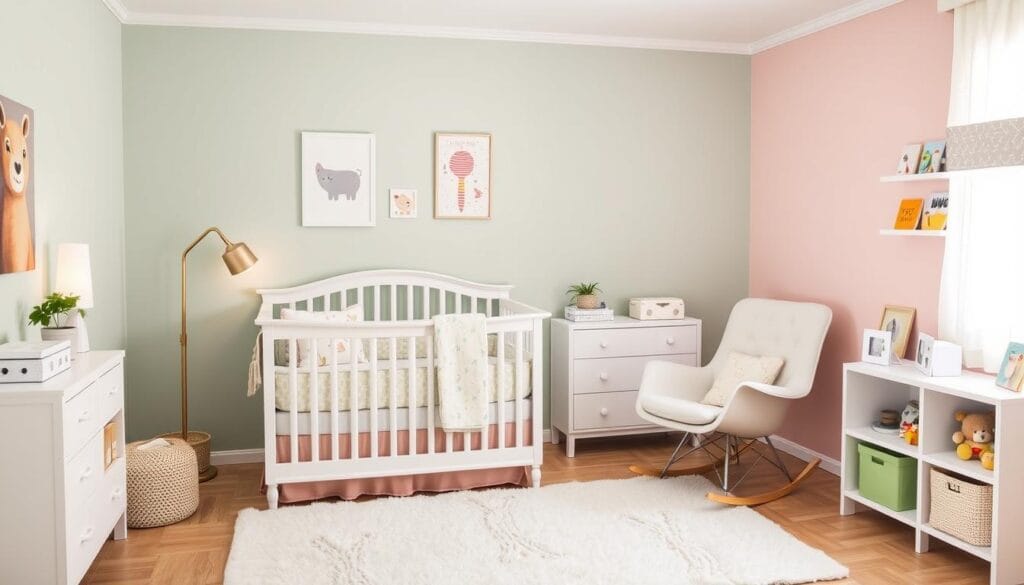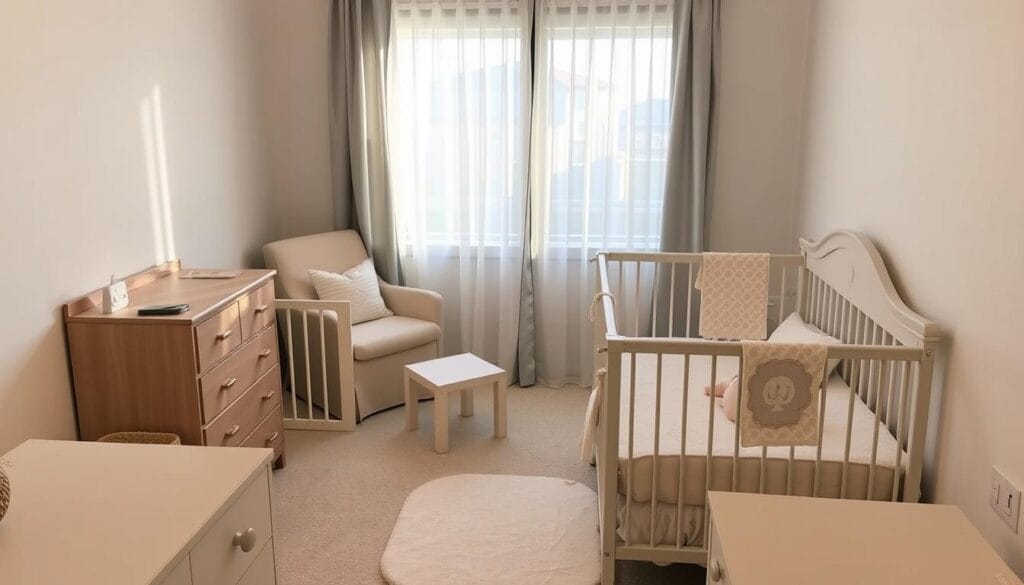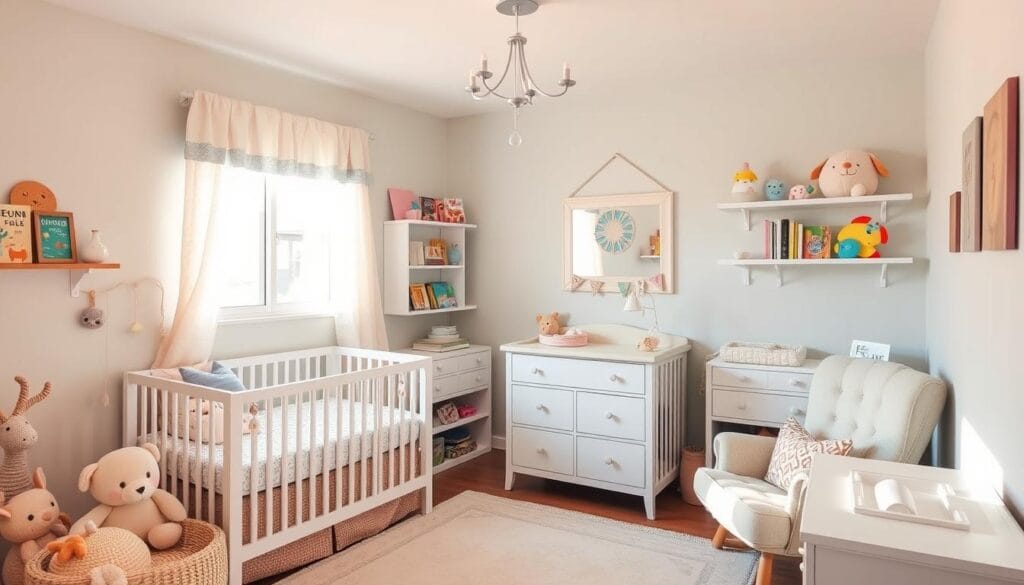Welcoming a new baby is an exciting time, and it also means preparing the home for baby. You’ll want to ensure your space is safe, comfortable, and meets all of your baby’s needs. This guide will help you with essential steps in preparing your home for your baby’s arrival.

Table of Contents
Nursery Setup: Creating a Safe Haven
Setting up a safe and cozy nursery is key when preparing for a new baby. This part talks about the baby furniture and nursery decor you’ll need. It also gives tips on decorating with your baby’s safety and comfort in mind, making a nurturing space.
Baby Furniture Essentials
The right baby furniture is the base of a good nursery. Start with a sturdy, safe crib that meets safety standards. A changing table with lots of storage makes diaper changes easy. A comfy rocking chair or glider is great for feeding and bonding.
Get dressers and shelves to keep your baby’s things organized and easy to find.
Decorating with Comfort and Safety
For nursery decor, aim for a calm and safe space. Pick soft, non-toxic fabrics for curtains, bedding, and rugs. Use calming colors and natural elements like wood or plants for a peaceful feel.
Make sure all nursery decor is securely attached and safe from falling or choking hazards.
By choosing baby furniture and nursery decor with safety and comfort in mind, you’ll create a nurturing space. This will be a safe haven for your growing family.
“A baby’s room should be a sanctuary, a place of comfort and security, where they can feel loved and protected.” – Child Development Expert
Baby-Proofing Your Living Spaces
Preparing your home for your baby’s arrival means more than just the nursery. It’s important to baby-proof your whole home. This ensures your child’s safety and prevents accidents. Let’s look at common dangers and how to baby-proof, child safety, and home safety your home.
Childproofing Hazards and Solutions
When baby-proofing your home, you need to tackle childproofing hazards. These include sharp edges, unstable furniture, electrical outlets, and choking hazards. Here are some childproofing solutions:
- Install safety gates at the top and bottom of staircases to prevent falls.
- Cover sharp corners and edges with protective guards or cushions.
- Secure heavy furniture, such as dressers and bookcases, to the wall to prevent tipping.
- Use outlet covers to protect your child from electrical hazards.
- Ensure all cleaning products, medications, and small objects are stored out of reach.
By tackling these childproofing hazards and using effective childproofing solutions, you make your home safer for your child. This lets them explore and grow safely.
| Childproofing Hazard | Childproofing Solution |
|---|---|
| Sharp edges | Protective corner guards |
| Unstable furniture | Wall-mounted anchors |
| Electrical outlets | Outlet covers |
| Choking hazards | Secure storage for small objects |
By focusing on baby-proofing and tackling childproofing hazards, you create a safe space for your child. A well-childproofed home is key to your child’s home safety and well-being.
Preparing the Home for Baby
Getting your home ready for a new baby is both exciting and challenging. As you feel the “nesting instinct” during pregnancy, focus on making your home safe and welcoming. Declutter, organize, and make space for your baby’s needs. This will boost your confidence and prepare you for parenthood.
Begin by checking your home and finding areas that need work. Start by getting rid of things you don’t need. This makes your home safer and calmer for your baby.
- Look at each room and plan where your baby’s essentials will go, like a crib and changing table.
- Organize storage for your baby’s clothes, toys, and supplies.
- Think about adding shelves or baskets to keep things tidy.
Creating a nursery is key. It’s your baby’s safe place. Choose furniture and decor that’s safe and looks good. It should make your baby feel comfortable and secure.
| Nursery Essentials | Importance |
|---|---|
| Crib | Provides a safe, comfortable sleeping space for your baby. |
| Changing Table | Allows for easy and convenient diaper changes, with storage for essentials. |
| Dresser | Offers ample storage for your baby’s clothing, linens, and other necessities. |
| Rocking Chair | Creates a cozy, soothing spot for feeding, comforting, and bonding with your baby. |
By carefully preparing your home, you create a nurturing space for your baby. This process helps you feel more organized and ready for parenthood. It lets you enjoy the “nesting instinct” and the journey of becoming a new parent.
“The home is the child’s first school, and parents are the child’s first teachers.”
Stocking Up on Babycare Products
Getting ready for your newborn means getting the right babycare products. You’ll need everything from diapers and grooming tools to feeding and nutrition items. Having these essentials ready will make the first days easier for you and your baby.
Diapering and Grooming Necessities
First, make sure you have enough diapers, wipes, and other diapering items. It’s smart to buy different sizes as your baby grows. Also, get soft washcloths, gentle baby shampoo, and a safe nail clipper for grooming.
- Diapers (newborn to size 3)
- Baby wipes
- Diaper rash cream
- Soft washcloths
- Baby shampoo
- Baby nail clipper
Feeding and Nutrition Supplies
It’s important to have the right feeding supplies, whether you’re breastfeeding, bottle-feeding, or both. Make sure you have bottles, nipples, and a good breast pump if needed. Also, get formula, baby food, and snacks that are right for your baby’s age.
| Feeding Supplies | Nutrition Items |
|---|---|
| Bottles and nipples | Formula |
| Breast pump | Baby food |
| Burp cloths | Baby snacks |
By getting these babycare products, you’ll be ready to care for your newborn. This will help them get the care and food they need in those first days.
Creating a Nurturing Environment
Preparing your home is just the start. It’s also key to create a nurturing space for your baby’s well-being. This means making a place that is soothing, stimulating, and safe. It’s about both the practical and emotional sides.
To make a creating a nurturing space, focus on these important points:
- Sensory Stimulation: Use calming colors, soft textures, and gentle sounds to make your baby feel safe and happy.
- Infant safety measures: Make sure the area is safe from dangers. Use child-proof locks, rounded edges, and pick safe decor.
- Personalized Touches: Add family photos or special keepsakes to make the space warm and welcoming.
It’s not just about the physical space. Your baby’s emotional and practical preparation is also crucial. Do calming activities like rocking or singing lullabies to comfort and love your baby.
| Key Considerations | Practical Tips |
|---|---|
| Sensory Stimulation | Choose soft, textured fabrics for bedding and decor Incorporate calming colors like pastels or neutrals Play gentle, soothing music or nature sounds |
| Safety and Childproofing | Install safety gates, outlet covers, and edge guards Secure furniture to the wall to prevent tipping Ensure all decor is non-toxic and baby-friendly |
| Personalization | Display family photos and cherished mementos Incorporate your baby’s name or initials into the design Choose soft, cozy textiles in your baby’s favorite colors |
By making a nurturing space for your baby, you help them adjust smoothly to your new life together. It’s all about meeting their physical and emotional needs.
Infant Safety Measures
Keeping your baby safe is a top priority when setting up your home. This checklist covers key steps to make your home safe for your infant.
Home Safety Checklist
Protecting your infant means childproofing your home. Here are some important steps to keep your living spaces safe:
- Install smoke alarms and carbon monoxide detectors on every level of your home.
- Secure cabinets, drawers, and appliances with child-proof latches to prevent access to hazardous items.
- Cover sharp edges on furniture and install safety gates at the top and bottom of stairs.
- Ensure all electrical outlets are tamper-resistant or covered with safety plugs.
- Keep cleaning products, medications, and other potentially harmful items out of reach in locked cabinets.
- Use safety latches or locks on windows to prevent falls.
- Anchor large furniture, such as dressers and bookshelves, to the wall to prevent them from tipping over.
- Install safety covers on ceiling fans and keep cords from blinds and curtains out of reach.
- Regularly check the water temperature in your home to ensure it doesn’t exceed 120°F (48.9°C) to prevent scalds.
- Maintain a clutter-free environment to eliminate tripping hazards.
By following these steps, you can make a safe and loving space for your baby to grow.

| Home Safety Item | Recommendation |
|---|---|
| Smoke Alarms | Install on every level of your home |
| Cabinet Latches | Use child-proof latches to secure cabinets and drawers |
| Electrical Outlets | Ensure all outlets are tamper-resistant or covered |
| Water Temperature | Maintain water temperature below 120°F (48.9°C) |
| Furniture Anchoring | Securely anchor large furniture to prevent tipping |
Nesting Instinct: Embracing the Transition
Pregnancy brings joy but also big changes. The “nesting instinct” helps you get your home ready for a new baby. It’s a natural urge to create a caring space for your family.
Self-Care During Pregnancy
Preparing your home for your baby is important. But, don’t forget to take care of yourself too. Caring for yourself is key for your health and your baby’s.
- Take time for relaxation and stress relief, like meditation or a warm bath.
- Eat well and drink plenty of water to keep your energy up and support your baby’s growth.
- Don’t ignore your emotional needs. Talk to your loved ones and seek help when you need it.
Balance home preparation with self-care to smoothly transition into parenthood.
“The more you take care of yourself during pregnancy, the better equipped you’ll be to handle the demands of new parenthood.”
The “nesting instinct” guides you to make a safe and caring home for your family. By focusing on self-care, you’ll be ready to welcome your baby and enjoy the journey together.
New Parent Readiness
Expecting a baby is exciting but can also feel overwhelming. It’s important to prepare both emotionally and practically. This will help you smoothly transition into being a parent. We’ll cover how to manage your feelings and get ready for the practical tasks ahead.
Emotional Preparation
Becoming a parent is a big change. You might feel happy, nervous, or a mix of both. It’s okay to feel this way. Take time to think about your feelings and lean on your loved ones for support.
Try activities that help you relax, like meditation or yoga. Remember, being kind to yourself is key during this time. You’ll face challenges, but with the right mindset, you can handle them.
Practical Preparation
Getting ready for a baby involves more than just feeling ready. Start by making a list of things to do, like setting up the nursery and buying baby supplies. Break these big tasks into smaller steps. Don’t be afraid to ask for help from family and friends.
Learn about caring for a newborn, including feeding, diapering, and soothing. Knowing these basics will make you feel more confident when your baby arrives.

“The key to a successful transition into parenthood is balancing emotional and practical preparation. With a little planning and a lot of self-care, you can create a warm, nurturing environment for your family to thrive.”
By focusing on both emotional and practical readiness, you’ll start your parenting journey with confidence. Every family is different, so trust your instincts. And don’t hesitate to ask for help when you need it.
Conclusion
Getting your home ready for a new baby is a big job. It needs careful planning and lots of attention to detail. This guide will help you make a safe, cozy, and caring space for your baby to grow.
Setting up the nursery and making your home safe are key steps. You’ll also need to get the right baby care products and make sure everything is safe for your baby. Every action you take helps make the transition smoother and gives your baby a great start.
Creating a safe and loving home is not just for your baby. It also helps you feel ready and confident as a new parent. You’re on the right path to welcoming your baby with love and a secure place to call home.
FAQ
What are the essential furniture and decor items I need for the nursery?
You’ll need a crib, changing table, dresser, and a rocking chair or glider for the nursery. For decor, choose soft textiles, calming colors, and safe accessories. This creates a cozy and safe space for your baby.
How do I baby-proof my living spaces?
First, find and fix hazards like sharp edges and loose cords. Use safety gates and cover sharp corners. Secure heavy items and lock cabinets and drawers with child-proof locks.
What babycare products should I have on hand before my baby arrives?
You’ll need diapers, wipes, and diaper rash creams. Don’t forget nail clippers, gentle soaps, and feeding items like bottles and bibs. Having these ready ensures you’re prepared for your baby’s arrival.
How can I create a nurturing environment for my baby?
Create a safe, calm, and stimulating space for your baby. Use soft lighting, white noise, and calming colors. Make sure your baby feels comfortable, secure, and has opportunities to explore.
What are the most important home safety measures I should take?
Install smoke and carbon monoxide detectors and secure cabinets and drawers. Cover electrical outlets and anchor heavy furniture. Check a home safety checklist to ensure your home is baby-ready.
How can I embrace the “nesting instinct” during pregnancy?
Use the nesting instinct to declutter and organize your home for your baby. Make sure to also take care of yourself during this time. It’s a great way to prepare your home and mind for your baby’s arrival.
How can I emotionally and practically prepare to become a new parent?
Prepare emotionally by managing your excitement and any concerns. Stock up on essentials and set up the nursery. Make sure your home is safe and welcoming for your baby.

1 thought on “Preparing the Home for Baby: Heartwarming Essentials for a Joyful Welcome”
Comments are closed.